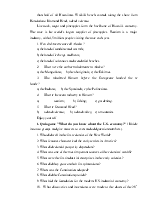













What was achieved in the first hundred years following independence is great. By 1890, for example, the U.S. was producing more iron and steel than Great Britain and Germany combined. In 1913 the United States accounted for more than a third of the world's industrial production. By the post-World War II era, the United States was producing 50 per cent of the "gross world product". The country endured a global depression in the first half of the 20th century, it surmounted sharp inflation, high unemployment, and enormous government budget deficit in the second half of the last century.
By 1900, according to several criteria, the U.S. had become the greatest industrial nation, and its citizens enjoyed the highest standard of living in the world. Today the average full-time employee works about 40 hours per week and the average family spends just 15 per cent of its income on food today, compared to 44 per cent in 1900. They are producing and consuming six times more goods and services per person, that they were
in 1900. In addition, they typically live about 30 years longer today as they have successfully fought many diseases.
Today, the American economy no longer dominates the world as it clearly did before. But with only about 5 per cent of the world's population and about 6 per cent of its land area, the United States still produces about 25 per cent of the world's industrial products, agricultural goods and services. Its gross national product (GNP) has more than tripled since the end of the Second World War.
America remains the world leader in many areas. Among these are, for example, biochemical and genetic engineering, aerospace research and development, communications, computer and information services, and similar high-technology fields. America's private industries are doing quite well. American firms and computers retain the largest share of the world market. Many countries now have their own silicon valleys, but the first and biggest computer research and production area is still Silicon Valley, near San Francisco, where some 4000 high-tech firms are located.
America's share of the world's land that can be used for farming is less than 8 per cent and only a tiny proportion of America's total population (less than two per cent) is involved in agriculture. America not only feeds her own people — one of the few industrialized countries that does so — but a great many other people in the world as well.
The United States entered the 21st century with an economy that was bigger, and by many measures more successful than ever.
2. Check your comprehension.
1. What progress had the U.S. achieved by the end of the 19th century? 2. What living standards do Americans enjoy today? 3. What did the country endure in the first half of the last century? 4. How has American "gross national product" increased since the W. W II? 5. In what fields of science is America the leader? 6. What are silicon valleys? 7. Where is American Silicon Valley situated? 8. How many people of America are involved in agriculture? 9. How much agricultural production does America produce? 10. With what economy did the U.S.A. enter the 21st century?
* * *
Tests
1. Choose the proper words and fill in the blanks.
/. The first settlers, living on small farms, were .
a) self-possessed; b) self-sufficient; c) self-confident.
2._ Great progress in industry development was achieved by the use of the___ .
a) refrigeration railroad cars;
b) nation's industrial infrastructure;
c) moving assembly line.
3.___________________ The U.S.A. is the world's leading of wheat and corn.
a) purchaser; b) importer; c) exporter.
4._______ The colonies of preserved many sights of the earliest U. S.
history.
a) the Midwest; b) the New England;
c) the South.
5._____________________________ The South includes mainly those states that formed________________ in
the Civil War.
a) the Confederacy; b) the Pepublic; c) the Union.
• 6. Great supplies of oil and natural gas helped the development
of in America.
a) restoration; b) revival; c) refinery.
7. The first and biggest computer research area iti America is
a) the Coastal Plain; b) the Silicon Valley; c) the Great Canyon.
8.___________________________ The American citizens enjoy one of the highest______________________ in the
world.
a) population density; b) budget deficit; c) standards of living.
9.______________________________ In the first half of the last century America surmounted ____________ .
a) inflation and unemployment;
b)bitter labour wars;
c) information crisis.
10. Hollywood, cinema and television centre, began its work in the of America.
a) Golden State; b) Sunshine State;
c) Empire State.
2. Read the text and choose the right answer to the ques tions below.
The LAST TWO STATES of the U.S.A.
Alaska
In 1959 Alaska became the 49lh state of the U.S.A. When the peninsula was purchased from Russia in 1867, most Americans had little interest in "the land of icebergs and polar bears". Now Alaska, the "Last Frontier", is America's largest state, but very few people live there.
Arctic Alaska has been the home of the Eskimos for many centuries
Уважаемый посетитель!
Чтобы распечатать файл, скачайте его (в формате Word).
Ссылка на скачивание - внизу страницы.